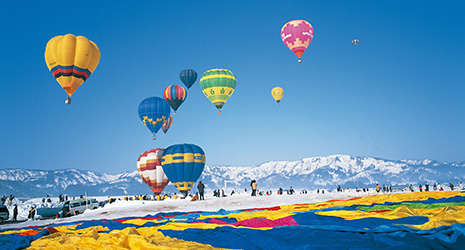February 2023
- English
- 日本語
Colorful Hot Air Balloons Flying Over Snowfields

Ojiya Fusen Ikki in Ojiya City, Niigata Prefecture 
A line of hot air balloons illuminated at night

Hot air balloons over snowfields

As winter turns to spring, a festival in Japan’s snow country fills the clear blue sky of Ojiya City, Niigata Prefecture with brightly colored hot air balloons floating above the snowy white landscape.

Located almost in the center of Niigata Prefecture, on the Japan Sea coast of northern Honshu, Ojiya City is known as one of Japan’s foremost high-quality rice producing areas and as a region of heavy snowfall. First held in 1977, Ojiya Fusen Ikki (Ojiya Hot Air Balloon Festival) is a spectacular event that takes place here over two days and features colorful hot air balloons floating above a snowy white landscape. Although Ojiya City has a population of just 33,000 or so (as of April 2022), prior to the coronavirus outbreak the local hot air balloon event attracted tens of thousands of visitors from Japan and overseas. This year the event will take place on February 25 and 26.
When the Ojiya Hot Air Balloon Festival began, hot air balloons were becoming increasingly popular in Japan, with a growing number of enthusiasts around the country making and flying their own balloons.
“Hot air ballooning in Ojiya City began in the mid-1970s. In winter, the rice fields are blanketed in thick snow, so hot air balloons have plenty of space in Ojiya City to land safely. This is how Ojiya City came to be regarded as the perfect location for hot air ballooning.” So says Ogino Ryuta, Tourism Manager of the Ojiya City Tourism Exchange Section.
“The first time the locals saw a hot air balloon descend on a snowfield they were astonished at the strange craft, and it quickly became a hot topic of conversation. This led the president of a company in Ojiya City that manufactured the world’s largest firework, the Yonshakudama firework (a type of firework shell measuring 120 cm in diameter), to spearhead an initiative that would engage the local community. That’s how Ojiya Fusen Ikki started.”
The ikki* of Ojiya Fusen Ikki means acting together for a single purpose. The name of the event conveys the desire of the locals to work together to get through the winter’s heavy snowfall and safely greet the spring, says Ogino.

At this year’s Ojiya Fusen Ikki the organizers are offering rides** in hot air balloons decorated with Ojiya’s specialty of colorful “swimming jewel” Nishikigoi carp. In addition, hot-air balloons flown by teams of enthusiasts from Niigata Prefecture and other parts of Japan will take part.
Another popular attraction every year is the “glow balloon” festival, a magical illuminated spectacle of hot air balloons held on the first day of the event. At night, orange flames appear over the snowfield as the burners of five to eight hot air balloons are lit in time to music or on command. A large firework display behind the balloons creates a spectacular show, drawing cheers of delight from the crowd.
Says Ogino, “Ojiya City is one of Japan’s leading rice producing areas. As well as this event, I hope people will come and enjoy the many delicious types of winter food and drinks, such as freshly brewed sake***, new soba****, and a variety of ramen.”
As winter gives way to spring, the hot air balloons drift slowly above the Echigo Plain against the backdrop of the mountain range, floating in the southerly winds above Ojiya. Ojiya Fusen Ikki has become an important event for the local community that announces the arrival of spring.
* The Japanese term ikki can signify both a united uprising of farmers against their feudal lords and working together in unified harmony.
** Passengers selected by lottery with priority given to Ojiya City residents.
*** Sake brewed from rice harvested in the most recent autumn and available for drinking in winter
**** Japanese soba made from buckwheat seeds harvested in the most recent autumn

